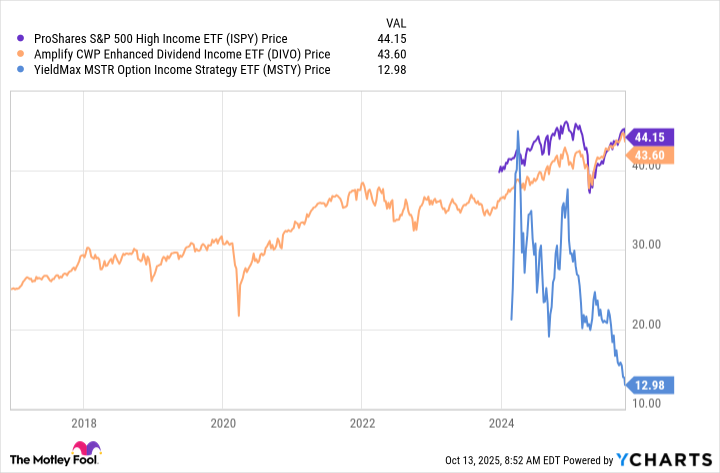Investors looking to generate income from their portfolio have myriad investment choices, ranging from simple, like buying dividend stocks, to more complex, like using options. If you don't like to complicate your life, you probably won't want to delve into options. But there's an easy way to use options that limits the effort you have to put in: options income exchange-traded funds (ETFs).
Here's why Amplify CWP Enhanced Dividend Income ETF (DIVO +0.73%) and ProShares S&P 500 High Income ETF (ISPY +0.56%) are two you might want to buy and hold forever. Meanwhile, Yieldmax MSTR Option Income Strategy ETF (MSTY +1.09%) offers a warning about reaching too hard for yield.
What do options income ETFs do?
An option is the right to buy or sell a stock or index at a future date at a set price. The person selling that right collects money from the person buying it, which is called a premium. The seller gets to keep that premium, generating income for the investor, no matter what happens with the option from that point on.

Image source: Getty Images.
There are two basic outcomes here. If the option gets used, which is known as getting exercised, the person who sold the option has to live up to their contractual obligation (which would mean either selling or buying the stock in question). If the option does not get exercised, the seller just gets to keep the premium, and nothing else happens. A lot of options never get exercised, which can make selling options an attractive way for more active income investors to increase the income their portfolios generate.
That said, options strategies can get very complicated. And even if you just stick to covered calls, one of the easiest options strategies to take, you still have to materially increase the time you spend watching your portfolio. But there's an easier way to incorporate options into your investment approach today using exchange-traded funds, which basically do all of the work for you.
Be careful what you ask for with options income ETFs
One of the best choices in the options income space for investors will be Amplify CWP Enhanced Dividend Income ETF, which has a 4.5% trailing dividend yield. This ETF is actively managed, buying a portfolio of around 30 stocks that management thinks have long-term growth appeal. After the portfolio is constructed, management strategically sells covered calls, the lowest-risk options approach, on a portion of the portfolio.

NYSEMKT: DIVO
Key Data Points
Amplify CWP Enhanced Dividend Income ETF has a solid history of providing a fairly reliable stream of monthly dividends and capital appreciation. What's most attractive about the ETF, however, is that it basically does what you would likely do if you managed an options income portfolio on your own. A $2,000 investment will get you around 45 shares of the ETF. While this ETF provides an attractive risk/reward balance, making it appropriate for even more conservative investors, it doesn't offer the highest yield.
ProShares S&P 500 High Income ETF, for example, has a 10.3% trailing yield. That's a very attractive number, but this ETF isn't just selling individual covered calls on stocks it owns. It sells options around the entire S&P 500 index (^GSPC +0.54%). This isn't necessarily more risky, but it is a very different style of investing than what most small covered call traders would likely do.

NYSEMKT: ISPY
Key Data Points
That said, there's an important distinction with ProShares S&P 500 High Income ETF because it uses daily options. The ETF has a relatively short history, but using daily options is expected to both generate income and provide more material upside potential than using longer-term options. So far, that has worked out, and if you are willing to reach a little for extra yield, daily options seem like a good risk/reward compromise. A $2,000 investment will let you buy around 44 shares of the ETF.
But be careful how far you reach for yield. Yieldmax MSTR Option Income Strategy ETF has an unbelievable 193.9% trailing yield. It uses a very complex strategy based entirely on one single stock, which it doesn't even own. And unlike the two ETFs above, the value of Yieldmax MSTR Option Income Strategy ETF has dramatically declined over its short history.
Data by YCharts.
Basically, you are generating a lot of income but at a very great cost. This ETF is actually just one of many high-risk options income ETFs that Yieldmax offers, with the price decline highlighting the extreme risk here. It might be appropriate for investors who own the underlying stock, which in this case is Strategy (MSTR +0.88%), but most investors would probably be better off avoiding options income ETFs like this one.
Options income ETFs are a great tool if used correctly
At the end of the day, like all investments, options income ETFs can be very helpful tools, or they can be tools of great destruction. It all depends on how you use them. For most investors looking to add some extra income via an options strategy, Amplify CWP Enhanced Dividend Income ETF will be the most appropriate choice. If you feel the need to reach for yield, however, make sure you understand the risks you are taking. For example, Yieldmax MSTR Option Income Strategy ETF's monster yield comes with a frighteningly low level of principal. Meanwhile, ProShares S&P 500 High Income ETF may provide a better balance of risk and reward for those willing to reach a little for a fatter income stream.

